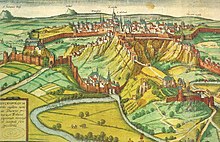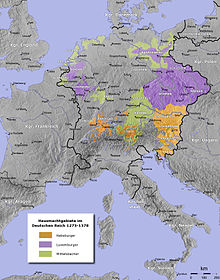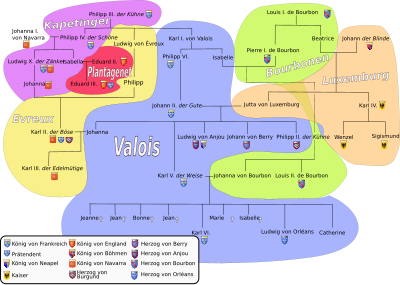House Luxembourg

The House of Limburg-Luxemburg (often also called House Luxemburg , Luxemburger or Lützelburger for short ) was a dynasty that between 1308 and 1437 provided four Roman-German kings of the late Middle Ages , three of whom were crowned emperors. Four Luxembourgers were both Bohemian kings and one Hungarian-Croatian king. The previous Hohenstaufen had provided five Roman-German kings or emperors and the subsequent Habsburgs provided twenty, not least because they had acquired the territorial inheritance of the Luxembourgers in 1437.
It is a branch of the House of Limburg-Arlon and should not be confused with the House of Luxembourg of the 10th and 11th centuries (the Wigerichen).
history
The founder of the line was Henry V of Luxembourg , he was a son of Walrams IV of Limburg (House Limburg-Arlon) with his second wife Ermesinde II of Luxembourg (House Namur), who inherited the county of Luxembourg from his mother while his Half-brother Heinrich IV of Limburg inherited the Duchy of Limburg. Henry V's younger son, Walram I , received the rule of Ligny and founded the branch line House Luxemburg-Ligny .
The first representative on the Roman-German royal throne was Henry VII in 1308 , a grandson of Henry V. He was able to appoint his son Johann as King of Bohemia (and its neighboring countries Moravia , Silesia , Lusatia and Glatz ) in 1310 , which then became the basis of their domestic power has been. Henry VII succeeded in enfeoffing 14-year-old Johann with the Kingdom of Bohemia by agreeing with Bohemian opposition circles on the deposition of the electoral king Heinrich of Carinthia ; Johann was married at the same time to the Bohemian Princess Elisabeth , a sister of Wenceslaus III. , with whose murder in 1306 shortly before the old ruling house of the Přemyslids had died out in the male line. Heinrich also succeeded in gaining the dignity of Roman-German emperor in 1312 , but his undertaking of a restauratio imperii failed . As a result, Johann gained a high reputation as King of Bohemia and pursued a very successful domestic power policy . Heinrich's brother Baldwin of Luxembourg , Archbishop of Trier , was also important: He was one of the most successful politicians of the 14th century and played a key role in determining the politics of the empire until his death.
The most important ruler of the House of Luxembourg was Johann's son Charles IV , probably the most successful domestic power politician of the late Middle Ages . As Margrave of Moravia, he took over the reign of Bohemia from his blind father in 1341 and was elected Roman-German anti-king against Ludwig the Bavarian in 1346 , while his father was still alive, followed his father as King of Bohemia from 1347, and was again in 1349 elected and crowned German King and rose to Roman-German Emperor and King of Italy in 1355, which he remained until his death in 1378. The Luxembourgers were also able to establish themselves temporarily in Brabant and Limburg (1355–1404) and in Brandenburg (1373–1415). In 1387 it was also possible to get the Hungarian royal crown into their hands (this plan had already been worked out by Karl). Karl managed to have his son Wenceslaus elected as Roman-German king while he was still alive. In addition, for some time it looked as if the power of the Luxembourgers and the provisions of the Golden Bull would de facto make the kingship hereditary. However, Charles IV also sold considerable parts of the imperial property .
King Wenceslaus was unable to meet the expectations placed in him. Initially, the House of Luxembourg not only lost its royal dignity (with the deposition of Wenceslas in 1400), but also a lot of respect. Under his half-brother Sigismund , the Luxembourgers succeeded in returning to the German royal throne in 1411, although it was no longer the hegemonic kingdom of Charles IV. With Sigismund, who could look back on a long and relatively successful reign (this is how the Great Schism was settled in 1417), the House of Luxembourg ended in a male line in 1437 and thus died out.
Sigismund's heir was his son-in-law, Duke Albrecht of Austria , who was able to unite all three of Sigismund's crowns, the Bohemian, the Hungarian and the German elected king. This contributed significantly to the rise of the Habsburgs , even if the unification of Bohemia, Hungary and Austria was only an episode for the time being. The possessions of the Luxembourgers west of the Rhine were integrated into the land complex of the House of Burgundy , which a few decades later was also inherited by the Habsburgs.
See also
- Master list of the House of Limburg-Luxemburg
- List of Luxembourg rulers
- List of Roman-German rulers
- List of Bohemian rulers
- List of rulers of Hungary
The kings and emperors of the House of Luxembourg
- Heinrich VII. (1278–1313), Roman-German King 1308–1313, emperor from 1312
- John of Bohemia (1296–1346), son of Henry, King of Bohemia 1311–1346 and Titular King of Poland 1311–1335
- Charles IV (1316–1378), son of Johann, 1346–1376 Roman-German King, 1347–63 King of Bohemia, from 1355 King of Italy, from 1355 Emperor
- Wenzel (1361–1419), son of Charles, 1363–1419 King of Bohemia, 1373–1378 Elector of Brandenburg, 1376–1400 Roman-German King
- Sigismund (1368–1437), son of Karl, Elector of Brandenburg 1378–1388 and 1411–1415, King of Hungary and Croatia from 1387, Roman-German King from 1411, King of Bohemia from 1419, Emperor from 1433
Emperor Heinrich VII.
King John of Bohemia
Emperor Charles IV
King Wenceslaus
Emperor Sigismund
literature
In addition to the literature listed in the articles of the above people:
- Martin Bauch, Julia Burkhardt, Tomáš Gaudek, Václav Žůrek (Eds.): Saints, Heroes, Angry Oaks . Rulership styles of the Luxembourgers (1308–1437) (= research on the history of the emperors and popes in the Middle Ages. Vol. 41). Böhlau, Cologne et al. 2017, ISBN 978-3-412-50164-8 .
- František Šmahel , Lenka Bobková (eds.): Lucemburkové. Česká koruna uprostřed Evropy. Nakl. Lidové Noviny, Prague 2012, ISBN 978-80-7422-093-7 (research overview ).
- Franziska Heidemann: The Luxembourgers in the market. Brandenburg under Emperor Charles IV and Sigismund of Luxembourg (1373-1415). Fahlbusch Verlag, Warendorf 2014, ISBN 978-3-925522-26-0 (newer monograph).
- Jörg K. Hoensch : The Luxembourgers. A late medieval dynasty of pan-European importance 1308–1437. Kohlhammer, Stuttgart 2000, ISBN 3-17-015159-2 (legible overall presentation with further references).
- Sabine Penth, Peter Thorau (Ed.): Rome 1312. The coronation of Henry VII as emperor and the consequences. The Luxembourgers as a ruling dynasty of pan-European importance (= research on the imperial and papal history of the Middle Ages. Vol. 40). Böhlau, Cologne et al. 2016, ISBN 978-3-412-50140-2 .






